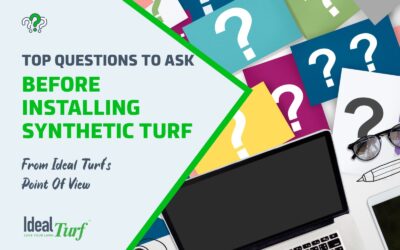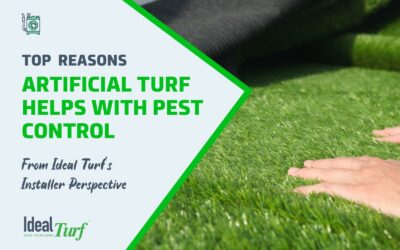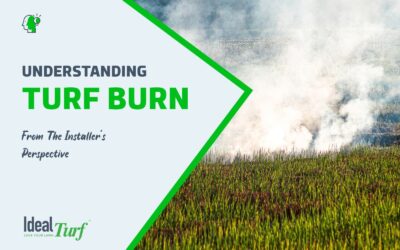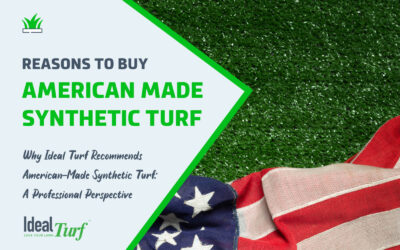The Top 11 Most Common Problems With Artificial Grass & How To Solve Them

Not many problems arise with artificial grass, which is why most people install it in the first place.
It’s impossible to kill, requires next to no water, and looks beautiful and green year-round without an ounce of fertilizer.
However, without proper maintenance and installation, issues can and do come up with synthetic grass lawns.
In this article, we’ll go over the most common artificial grass problems you’re likely to encounter, as well as solutions for each of them.
Spoiler Alert: Most of them are easier to prevent than to cure.

What are the Most Common Artificial Grass Problems?
At first glance, installing artificial grass may not seem very difficult.
It’s just plastic, outdoor carpet, right?
Not exactly.
The installation process is more nuanced and intensive than most people think, and getting it right is crucial to preventing future problems.
Most synthetic turf issues are caused by a DIY turf installation, an inexperienced turf installer, or an installer who is looking to save money by cutting corners.
Below are the most common problems that occur with artificial grass lawns.

PROBLEM #1: Choosing the Wrong Type of Artificial Grass
Most people don’t realize that artificial grass isn’t a one-size-fits-all product.
Modern artificial grass comes in a variety of different forms, textures, grades, and colors.
Each turf product is intended for a specific residential application or commercial use.
Putting green turf is completely different from pet turf, which is different from sports turf, and so on.
Choosing the wrong artificial grass for your area is a sure way to be disappointed.
SOLUTION: Research, Research, Research
The best way to ensure that you choose the right type of artificial grass for your residential or commercial property is to do your homework.
Educate yourself about the different types, features, and specifications of fake grass so you can make the most informed decision.
If you have questions, an experienced turf dealer at a showroom is a great resource to help you navigate through the many choices.
They can explain the different benefits and drawbacks of each brand and product.

PROBLEM #2: Loose or Lifted Edges
The edges and corners of your turf installation can become loose if they are not properly secured.
This creates a tripping hazard, not to mention it also looks terrible.
In extreme weather conditions like heavy wind, tornados, or flooding, loose turf can even lift off the ground!
SOLUTION: Use Staples to Secure Turf
The best way to ensure your turf stays secured is with turf staples, stakes, or nails.
These should be 4 – 6 inches in length and placed every 1 – 2 feet around the perimeter of your project.
A professional will have the knowledge and training to make sure your fake grass has secure, smooth edges that will stay in place looking great for years to come.

PROBLEM #3: Drainage Problems
Most natural lawns have issues stemming from a lack of water, while artificial lawns can suffer if they get too much of it.
Without adequate drainage, water can pool under your turf, causing it to bubble and shift.
It also creates a prime breeding ground for mosquitos, moss, mildew, and bacteria.
Proper drainage is crucial to a great artificial grass installation.
Incomplete drainage generally happens when:
- The base is too compacted or unevenly compacted
- The turf is improperly edged if it’s on or near concrete
- The gravel layer underneath was not evenly distributed
- An incorrect base type was used for the turf, usually the wrong type of gravel for the soil underneath or lack of tiles on concrete
SOLUTION: Install Proper Sub-Base, Choose the Right Backing & Replenish Infill Yearly
Turf drainage begins with the sub-base that’s prepped during the installation process.
A base of gravel or other aggregate will allow water to continue draining down and away once it has passed through the turf into the soil.
Choosing a turf product with the appropriate backing will also help mitigate drainage problems.
Even when the sub-base is perfectly prepared, if your soggy yard needs a product with fully permeable backing but you choose one that’s hole-punched, you’ll still run into issues with standing water.
When you shop for artificial grass, select an option that features the appropriate level of drainage for your climate and installation site.

PROBLEM #4: Odors & Stains
If you’re looking for why your artificial lawn smells funny, look to your favorite canine companion.
Dogs are the most common cause of odors in fake grass.
The ammonia and bacteria in your pooch’s urine are the culprits of the stench.
They tend to build up in the fibers of artificial lawns, making you think twice about inviting your neighbors over for a backyard BBQ.
And even if guests can’t smell anything, if left untreated, a urine stain can mark the spot where Fido marks his spot.
SOLUTION: Antimicrobial Turf & Regular Cleaning
The best way to deal with odors and stains is to prevent them before they happen.
Selecting artificial grass that has antimicrobial properties, like our Microbe-Safe™ turf backing, will go a long way to inhibiting bacterial growth.
In addition to antimicrobial infill and backing, promptly removing solid pet waste from fake grass for dogs and rinsing pet urine with a hose will help keep your turf odor-free.
Rinsing your turf regularly is also the best way to prevent staining.
For particularly stubborn odors, you can use mild cleansers like vinegar and baking soda, or purchase enzymatic cleaners specifically designed for artificial grass.

PROBLEM #5: Bumps, Sinking Spots & Holes
Over time, lumps, bumps, and dips can form in your artificial grass lawn, ruining the pristine aesthetic that made you want fake grass to begin with.
Once again, it’s usually poor installation that’s to blame.
A sub-base that’s not properly compacted or level can cause these bumps, slumps, sinking spots, and holes in your turf installation.
SOLUTION: Properly Compact Sub-Base
Every house needs a good foundation, and so does every artificial lawn.
Creating a good foundation takes time and effort.
Installing fake grass isn’t as easy as scraping off the old grass and rolling out the new.
The site must be scraped, leveled, and free of any bumps, rocks, or debris.
Then, the native soil is tamped down using a plate compactor.
After that, a layer of crushed rock goes down, followed by a finer layer of granite dust, then weed barrier, then the turf.
This installation process seems lengthy—especially to lay down sod that doesn’t even grow.
However, doing it right the first time will create the beautiful, smooth lawn you have pictured for your landscape.

PROBLEM #6: Weeds
Artificial turf makes it difficult for weeds to grow, but not impossible.
If weeds make it through synthetic turf, they’ll most likely get through around the edges or (more rarely) through the drainage holes in hole-punched backing.
Weeds can also find their way onto your turf from the seeds dropped by birds and trees.
SOLUTION: Install Weed Barrier
Many turf installations include a weed barrier to prevent weeds from making their way through the drainage holes and seams.
Most weeds in artificial grass start growing on top of the turf, and they can easily be removed by pulling them out.

PROBLEM #7: Moss Buildup
Fake grass does not encourage the growth of moss or algae.
In rare instances, however, the organic matter or debris trapped in the grass does.
Moss and algae are tricky to remove, so in this case, prevention is the best course of action.
SOLUTION: Leaf Blower or Pressure Washer
Carefully using a pressure washer or a leaf blower on your turf can prevent moss from growing.
Either of these tools will remove twigs, dust, and debris from nestling between grass fibers.
Pay special attention to areas in shady, cool spots in your yard, as well as low areas that are prone to standing water.

PROBLEM #8: Visible Seams
After all the money and time spent on your project, an obvious line that runs through the middle of the turf is the last thing you want to see.
Most artificial lawns have seams, as they occur when two larger pieces of turf are joined together.
When installed properly, you can’t tell where one section of turf begins and the other ends.
When done improperly, you’ll see a line running straight through your turf.
SOLUTION: Work With an Experienced Turf Installer
Fixing visible seams after installation can be costly.
To prevent this error, work with an experienced and reputable turf installer.
Your installation team will begin by laying out the turf perfectly and trimming all of the excess material.
At this point, the sections are ready to be seamed together.
All of the sections need to be laid with the grass blades pointing in the same direction.
Seaming techniques vary from job to job, depending on the materials, sub-base, and location.
They include using seaming tape with adhesives (glue), sewing, and/or tacks and nails.
Once the seams are completed, the team does the final trimming along all the seams and edges of the grass.
If the project is done well, the lawn should look like one seamless piece of artificial grass.

PROBLEM #9: Limited or No Warranty
A company’s warranties will tell you a lot about the quality of their products and services.
Less-experienced companies often have only limited warranties.
In some cases, they may not have anything in place at all.
If you have a problem with your artificial grass, having no warranty or guarantee to fall back on could cost you a lot of money!
SOLUTION: Choose Ideal Turf!
Ideal Turf stands behind its turf products and world-class installation team.
We offer clients a 1-year installation warranty and a manufacturer’s warranty on our turf products that ranges from 15 – 20 years.
We have been serving thousands of happy customers throughout Texas and Oklahoma since 2013.

PROBLEM #10: Melting From Energy Efficient Windows
Energy-efficient windows are a great way to keep your home cooler by reflecting the sun away from your home.
However, the reflection caused by energy-efficient windows can magnify the sun’s rays like a magnifying glass—to the point of melting your turf!
SOLUTION: Install Screens or Protective Films
If you have energy-efficient windows, and you’re concerned about the potential damage to your artificial grass, take heart.
You can still enjoy all of the benefits of artificial grass AND your energy-efficient windows.
The solution is simple—place screens or protective films on the outside of the windows that cause the reflection.
This is an easy, relatively inexpensive solution.
Having screens or protective films on the outside of the window will also benefit your home’s efficiency.

PROBLEM #11: Surface Heat
Artificial grass is made of nylon or polypropylene, which are types of plastic, so it gets hotter in the sun than natural grass, which has water running through it.
Most folks with synthetic lawns do not report that the increased surface temperature keeps them from enjoying their grass.
However, depending on the intensity of the sun in your area, your turf can become hot during summer months—particularly if you have pets or children that like to go barefoot.

Wrapping up the Most Common Problems With Artificial Grass
Many homeowners and businesses opt for artificial grass for its pristine look and low maintenance profile.
It’s important to note, however, that artificial grass isn’t maintenance- or problem-free.
Most problems with artificial grass stem from sloppy installation by an inexperienced installer, or from not keeping up with basic turf maintenance like rinsing.
The easiest way to avoid a host of problems with your new artificial lawn is to choose an experienced artificial grass company like Ideal Turf.
We know how crucial having an experienced installation team is to the success of each project.
Unlike many other companies, we don’t contract out on installation; we keep our installers in-house so they can get the experience and training they need to make your lawn turn out great.
If you’re interested in an artificial grass installation in Texas or Oklahoma, please contact Ideal Turf today.
Get your FREE Artificial Grass Design & Installation Estimate by clicking “GET A QUOTE” button or feel free to give us a call at 800-204-4650.
Author: Tim Taylor
Recent Posts
- How Synthetic Turf Helps Keep Fleas and Ticks Out of Your Texas and Oklahoma Yard
- Porches, Patios & Personality: Creating Outdoor Spaces Texans Love
- Turn Your Backyard into a Golfer’s Dream: Custom Putting Greens by Ideal Turf
- Why Texas Pet Owners Are Choosing Pet-Friendly Artificial Grass from Ideal Turf
- Why More Texans and Oklahomans Are Turning to Artificial Grass for a Greener Future






